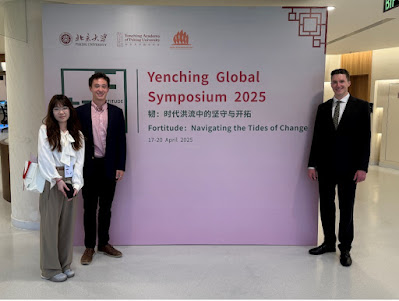Innovations in Online Community-building: how doodling is bringing the HNC together
As anyone who has lived through the 2020 pandemic can tell you, it is no secret that virtual community building is not without its challenges. There are many school activities that we simply cannot participate in. Moreover, there is much that is missed in a virtual setting. The fact that we aren’t living in the same space means that many shared experiences and nuances are harder to develop. Nonetheless, our cohort has developed many innovative strategies to build community virtually. MAIS student Nathan Rose talks about overcoming these challenges, and introduces his own role in rallying students together at the Hopkins-Nanjing Center.
One challenge in building a virtual community is time—more specifically, time zones and time differences. It’s known that the US and China are on almost completely opposite time schedules: the difference between the Eastern Time Zone and Beijing time is usually 12 hours (though increases to 13 during the fall and winter). This “perfectly opposite” time difference paradoxically was somewhat easy to understand: Chinese mornings are DC evenings, and DC mornings are Chinese evenings, giving approximately 6 hours of shared time per day. Our classes therefore follow a crepuscular schedule; class times are in the morning and evening (China time) to best take advantage of this shared time. While I think this schedule is the best possible schedule given the circumstances, it makes competition for shared time slots even more intense.
It can be difficult to find time for an event or activity that doesn’t conflict with classes and is at a reasonable time for both international and Chinese students. This problem is compounded by different time zones. I am currently living in Mountain Standard Time in the US, which is 2 hours earlier than EST and 15 hours later than China time, meaning my classes are earlier than expected. This is good for my evening classes (China morning classes), but a bit painful for my morning (Chinese evening) classes. This time difference is made more intense for students living on the Pacific coast—where the latest morning class occurs at 6 am. European classmates also face similar time-zone woes. This means that choosing a time for an activity that works for all students in all time zones is an incredibly difficult challenge—usually, someone will miss out.
However, I believe the same inventiveness that allowed us to create a virtual community across continents will allow us to create a community across time. The solution, as I see it, is in developing asynchronous activities. Our current crepuscular class schedule is designed to synchronize across time zones, which is essential for class. However, this schedule gives students significant time during the day. For instance, I am most active in the afternoon, which is unfortunately China’s early morning. Similarly, China’s afternoons are my early mornings, meaning that when most Chinese students are awake I am (hopefully) fast asleep. By disconnecting participation from specific times (i.e. asynchronous activities), students can participate in activities when it suits them, building community across time zones.
What would be an example of such an asynchronous activity? While I think certain games have great asynchronous potential (Minecraft Realms comes to mind), I’d like to highlight an activity I recently organized with the HNC group: a game called “squiggle.”
“Squiggle” is an activity that is one-part artistic exercise and one-part casual party game. The rules are simple: one person takes a marker and a piece of paper and draws a squiggle on it. This squiggle is then copied and given to all participants. Participants use these squiggles to make a complete drawing, incorporating the original squiggle into the final piece. The goal isn’t to make the most beautiful piece, but simply to be creative and expressive. Once everyone is finished drawing, people share their drawings with the group. An example “exhibition” is shown here, with the original squiggle in red.
While squiggle has traditionally been played in person, I realized that it could be made virtual and asynchronous relatively easily. The initial step of making a squiggle can either be done by taking a picture of a marker-and-paper squiggle, or by opening any graphics software and drawing a squiggle. The squiggle “file” is then sent out to all participants. Participants have one week to make a drawing using this squiggle. They can spend as much time or as little time as they want to draw, and are only expected to draw whenever they have some free time. People then send their finished squiggles to the group before the deadline (for now, Sunday 10:00 am Beijing time), creating a small virtual exhibition. The next person draws the next squiggle for next week, and the activity continues.
This week’s squiggle is posted here in blue. I welcome anyone reading this is to give it a shot!






